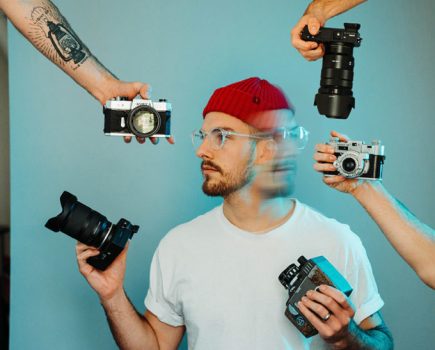Snowdrops are strongly associated with Imbolc, a festival celebrating the returning of light and the beginning of spring. From January onwards, woods, riverside banks, parks and gardens are awash with nodding white flower heads, lifting the spirits and offering a reminder that winter is drawing to a close. Photographer and folklorist Angi Wallace is familiar with the symbolism of flowers and often uses this language in her work.
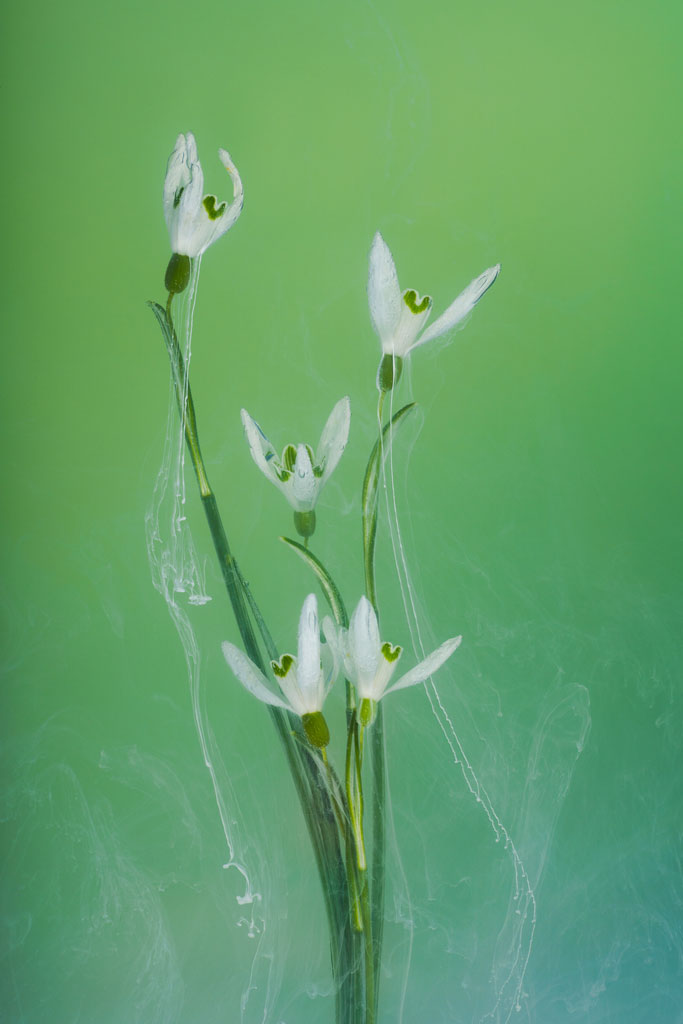
Last year her interest in floriography took a leap forward when she stumbled across a series of flower portraits by Robert Peek, a conceptual photographer based in the Netherlands. ‘His social media account was full of flowers underwater with white fluid flowing over them in a magical, ethereal way,’ she says. ‘I was unfamiliar with the technique, and I was keen to explore it for myself.’
Time to experiment
Having searched online, Angi could find little by way of instruction. ‘I spent weeks trying to find out how to do it and I couldn’t find anything, so I just played around and tried to make it happen,’ she reveals. Her first attempts were hit and miss, with plenty of wasted time and resources, but she continued to experiment. ‘As soon as I tried the technique, I knew I had to do something with it,’ she explains, ‘but I had to do something different and put my own stamp on it.’ Unlike Peek, Angi decided to use her love of floriography to create fascinating backstories to her flower portraits.
Her submerged snowdrops, for example, were shot with a green background to indicate new life, then white liquid (milk) was introduced to suggest hope, purity and innocence. Finally, red and white threads were tied to the stems to link the arrangement to an aspect of Romanian folklore. ‘When I started creating underwater flower images it was all about puzzling out the process, but now I choose flowers due to their links to folklore, spirituality and paganism,’ says Angi.
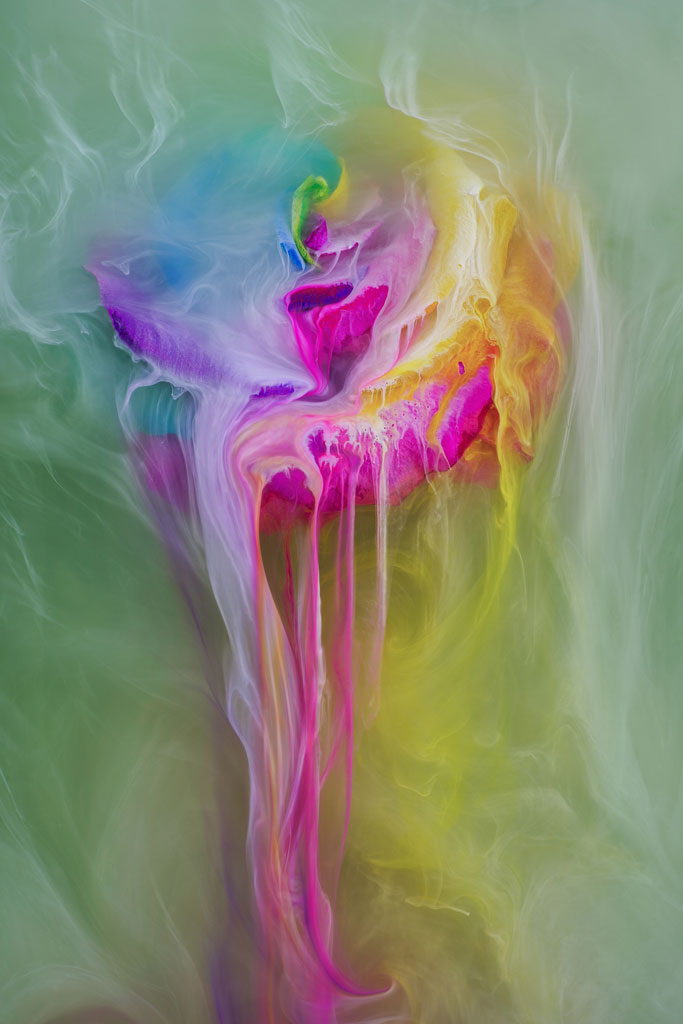
Gather your tools
Creating a submerged flower picture requires a fair amount of planning, and a few unusual tools. First you need a glass container: Angi uses a small, but reasonably tall, fish or insect tank, but admits that the black strips down the sides are not ideal. ‘You could use a tall vase, but any curves or distortions can cause unwanted reflections,’ she explains. ‘Plus, you need to be aware of unwanted colour casts.’
Next, you need something to anchor your flowers to the bottom of the tank (unless you’re a fan of the free-floating look). This is where DIY skills come in handy. While Angi has experimented with various objects, one of her favourite ways to anchor flowers is to tie slate coasters together and glue floristry wire to them to help position her blooms. ‘They don’t take up much room in the tank and they are so heavy they will weigh down just about any flower,’ she assures.
Become a scientist
Next, you need tools to help you apply liquid to the flowers in the tank. ‘I buy pipettes in packs of 10 or 20 so I can keep colours separate and avoid contamination,’ says Angi. She also uses syringes with fine needles – insulin syringes are best as they allow her to drop tiny amounts of liquid onto the petals. It has taken a lot of trial and error to find liquids that suit Angi’s taste, but at present she is using cow’s milk, acrylic inks, food colouring and juices (beetroot is a favourite).
‘Some mediums are heavier than others and will sink faster so it’s a good idea to test them in a glass or a vase of water before using them in a big tank,’ she says. Skimmed milk, for example, dissolves faster than full fat, which is why Angi prefers the latter. As an environmentally conscious photographer, she tries to use liquids that can be disposed of safely and is keen to find eco-friendly alternatives to paint.

Prepare to shoot
If you’re not a clean freak, shooting submerged flowers might turn you into one. ‘You have to clean everything thoroughly before you start,’ says Angi. ‘I even wash my arms to prevent fluff from my clothes getting into the water!’ With arms washed and the tank positioned on a towel, Angi fills the pipettes and syringes and lays them in a plastic tray. ‘You’re going to be adding ink with one hand and triggering your camera’s remote release with the other, so you need to keep your tray nearby,’ she says.
Next, Angi positions a backdrop against the back of the tank (ensuring the glass is dry and free of condensation). Black card is good for starters, but Angi also uses coloured card and sometimes even prints of her own as backdrops. ‘The background colour will only show for a short while because you build up your own colours in the tank as you add the liquids,’ she explains. Having cleaned and positioned her flowers, Angi waits for everything to settle, then uses a knife or pipette to remove unwanted air bubbles.
Set to work
While the flowers are carefully arranged (and pushed against the side of the container), the end result can still be unpredictable. ‘It’s very freeing,’ says Angi. ‘A lot of my photography requires careful planning, and the order of things is quite rigid, but here I can play around – I add a bit of this and a bit of that and the magic happens!’ But magic isn’t the same thing as luck.
Angi has spent hours experimenting with liquids, colours, flowers and tools. ‘It’s all good fun,’ she smiles. ‘You never get the same result twice.’ Some flowers change shape in the water, for example, while others, if left for a few hours, slowly become transparent. ‘You need to be ready to change your plans,’ urges Angi. When it comes to adding liquid, she lowers the pipette to her chosen spot, applies pressure and then removes it slowly. ‘Some liquids settle at the bottom and then start climbing up the sides,’ she reveals. ‘You have to be patient and wait to see what happens.’
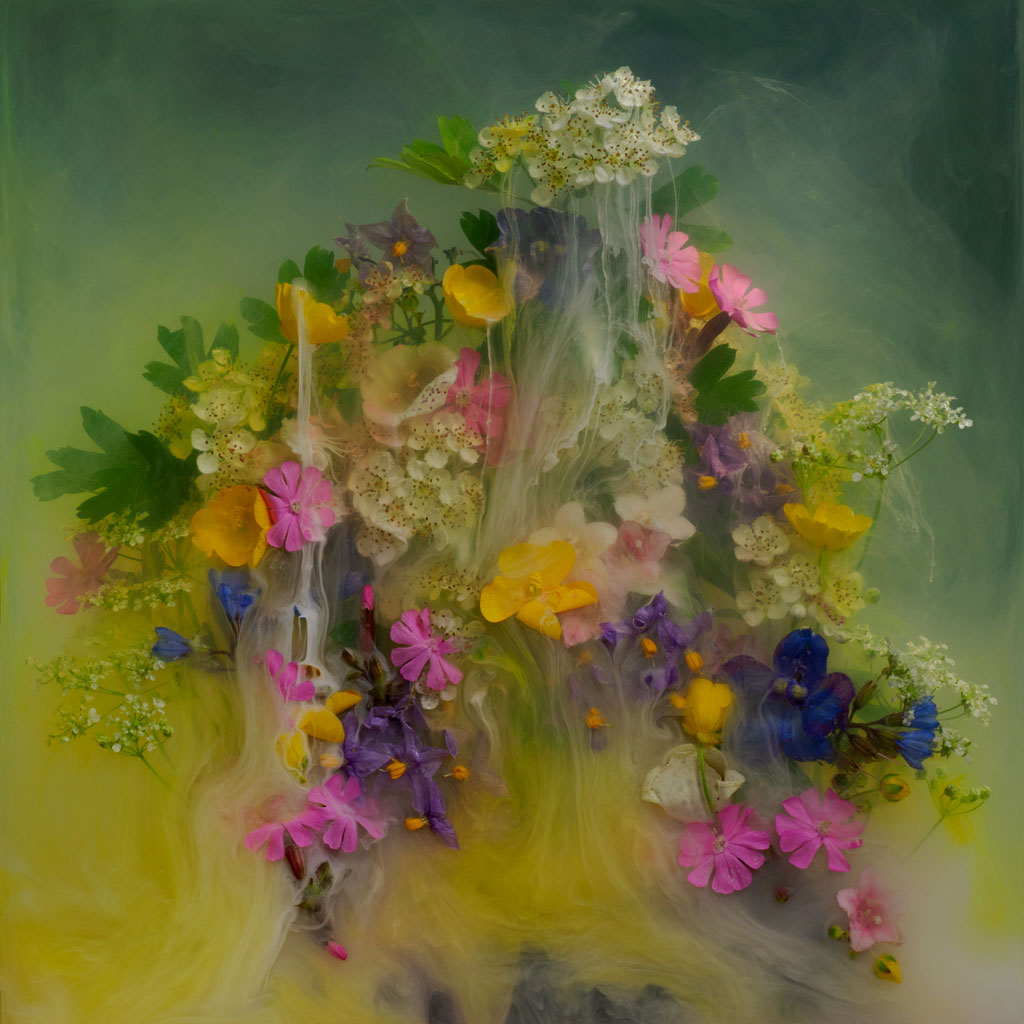
Get it right
Looking at the vibrancy and detail of Angi’s work, it’s hard to believe that some pictures are straight out of camera. ‘It’s not easy, there’s often plant debris in the water, but where possible I like to remove dirt and debris with a pipette,’ she explains. The secret lies in cleaning your equipment and taking the time to set everything up properly.
To reduce unwanted reflections, for example, Angi hangs black material behind her camera (she uses an Olympus OM-1 and a Sony A7 III, her lens of choice is a 90mm / 180mm macro) and tapes over reflective parts of her tripod. ‘I also try to stand to one side of the tank so that my reflection doesn’t appear, and I wear black clothes,’ she adds.
With the focal plane parallel to the tank, and the camera set to manual focus to avoid lens hunting, Angi experiments with apertures until she gets the effect she desires. ‘I shoot wide open for a mysterious look or close the aperture down to get more in focus,’ she says. ‘I’m not afraid to play with contrast, white balance or saturation in-camera.’
Getting the light right
While shooting in ambient light is an option, it’s not something Angi recommends. ‘I saw a video of someone attempting this technique in their backyard once and they were really struggling with reflections,’ she recalls. ‘It’s not surprising because the light is coming from every direction!’
Once again, she advises playing around with light sources and positions. ‘It can be tricky to get the light right and to avoid plants creating shadows,’ she admits. ‘You have to experiment.’ For ultimate control, Angi uses artificial sources. ‘If I’m using continuous light, I might add a modifier such as a snoot to train it on a small section of the tank,’ she explains.
Gridded flash, however, is her first choice. ‘I position it from the side and slightly in front. It helps to create shadows where I need them and gives shape to the flowers.’ Of course, as the water starts to get murky due to the coloured liquid, less light reaches the flowers, which is when Angi positions the light at 45°. As with everything here, flexibility is key.
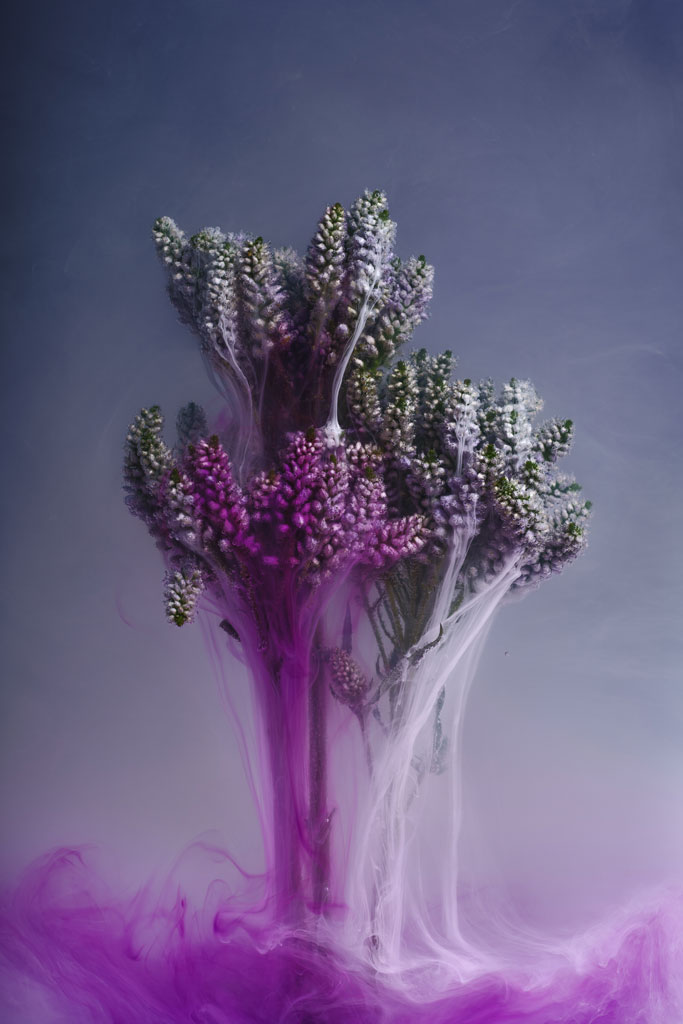
The submerged flower series is one of many projects Angi is working on at the moment. A true polymath, she also paints, makes jewellery and creates digital textures. ‘This is just the start,’ she laughs. ‘I’ve got so many ideas. I’m going to cover all of the elements: water, air, earth and fire. It’s actually a massive project.’
As we say goodbye, I can’t help marvelling at her enthusiasm and her ability to generate new work. How does she do it? ‘Creativity is my middle name,’ she laughs. Somehow, I believe her.
Angi’s kit list for submerged flower photography
Liquids: Angi has tried everything from cow’s milk to acrylic paint, beetroot juice and food colouring in her submerged flowers series. Different liquids have different properties: some sink faster than others, for example. The temperature of the water also dictates how quickly or slowly a liquid will move. Generally speaking, the colder the water the slower the movement.
Flower frogs: While Angi likes to anchor flowers to the bottom of the tank using slate coasters, she also uses flower frogs and vases. ‘If you want to create still-life arrangements you can put Blu Tack in a vase and secure flowers inside it before placing it in the tank,’ she advises. ‘But creating a still life in water is tricky because everything wants to float!’
Pipettes and syringes: While you can add liquid to the water with a small jug or a bottle with a thin neck, it’s best to use pipettes or syringes with fine needles. Angi likes long pipettes because you can use them without having to reach too far into the tank, which can disturb the water. Give them a tap to remove any air bubbles before using them.
Camping shower: Repeatedly emptying a tank of water can be labour-intensive and time-consuming, but Angi has found a brilliant hack. ‘I use a battery-operated camping shower to empty the tank,’ she laughs. ‘You stick one end of the tube in the tank and the other end in a bucket, and off you go!’ It’s a good idea to put a few towels down first.
Angi’s top tips for submerged flower photography
Try natural juices
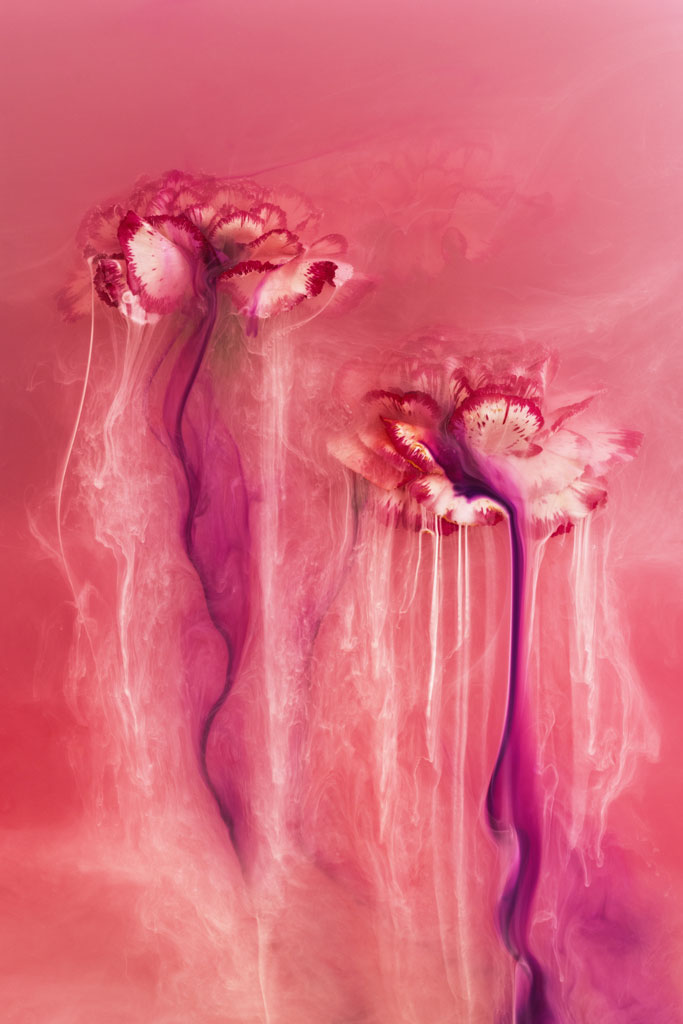
Angi has been trying to find eco-friendly alternatives to acrylic paint, which has led her to experiment with vegetable juices. So far, beetroot is a firm favourite. ‘Nature is my religion, so I try to use food colouring or natural products where possible,’ she explains.
Let things dry

When there’s not much growing in the garden, Angi turns her attention to photographing submerged dried flowers. ‘Before you put them in the water you need to remove dust or particles that have built up,’ she warns. ‘Be prepared to let parts just float off!’
Head to the back

To begin with, black backgrounds are best as they help the colours to stand out. Once you get used to how the liquids move it’s worth experimenting with coloured backdrops. Angi enjoys using her knowledge of colour theory when pairing background and subjects.
Float away
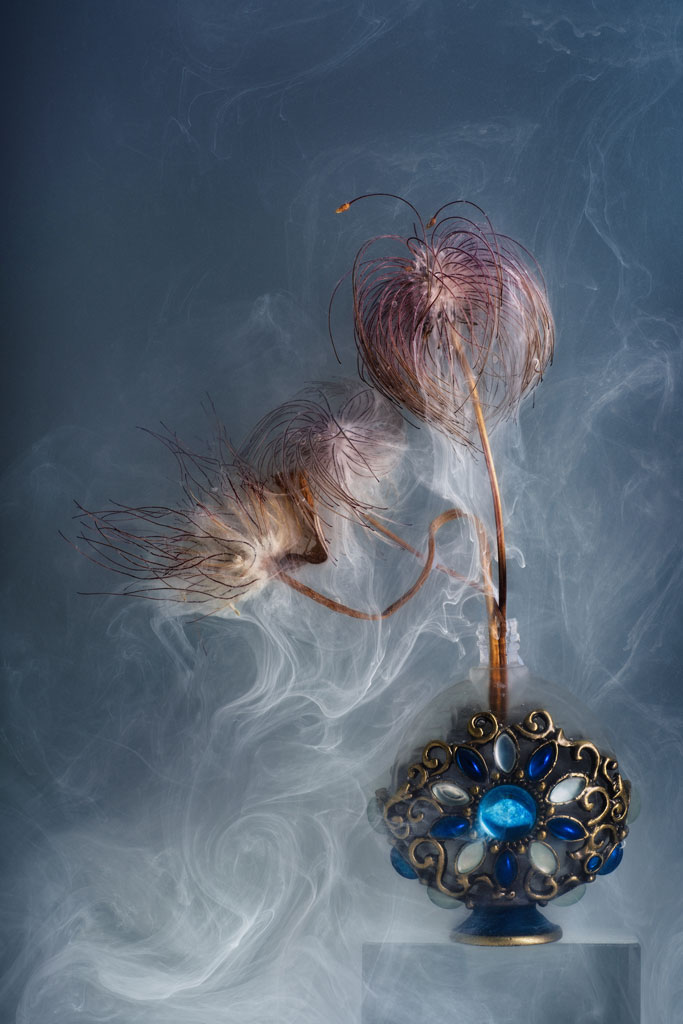
As a fan of still life, Angi likes to use vases and other props in her work, but she admits it’s tricky underwater! ‘Only half of my attempts have been successful,’ she laughs. ‘Everything wants to float, so you need to glue things together.’
Hold your position

Flower frogs, floristry wire and slate are all good for securing flowers. Angi occasionally pushes the wire inside stems to hold them in position. When she has finished, she might photograph the flowers floating. ‘Why waste all that coloured liquid,’ she smiles.






